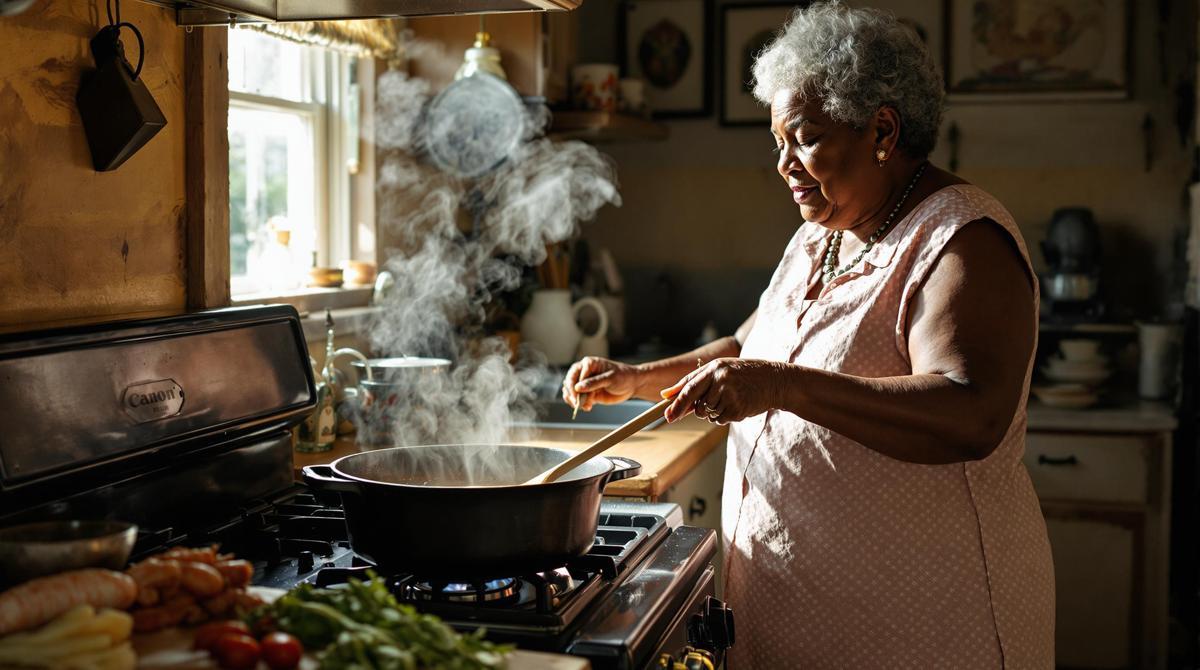There’s something deeply comforting about a proper gumbo simmering on the stove, filling the kitchen with aromas that transport you straight to New Orleans. My grandmother taught me to make gumbo on sticky summer afternoons in her Louisiana kitchen, insisting that patience was the secret ingredient you couldn’t measure. “A proper roux can’t be rushed,” she’d say, wooden spoon moving rhythmically across the cast iron. The dish’s fascinating history – a beautiful marriage of African, French, and Native American influences – is reflected in its very name, derived from the West African word for okra: “ki ngombo.” This isn’t just dinner; it’s cultural heritage in a bowl.
The Soul of New Orleans Gumbo 🍲
Authentic gumbo begins with a dark chocolate-colored roux – the foundation that gives this dish its characteristic depth. While many home cooks are intimidated by this crucial step, I’ll guide you through creating the perfect roux without burning it. The “Holy Trinity” of Creole cooking (onion, celery, and bell pepper) builds the aromatic base, while the protein combination of chicken, andouille sausage, and Gulf shrimp creates that quintessential New Orleans flavor profile.
Whether you lean toward Creole style (featuring tomatoes) or Cajun (typically without), the techniques I’ll share work beautifully for both traditions. My personal approach merges elements from both – a dark roux with a touch of tomato and both okra and filé powder for that distinctive silky mouthfeel.
Essential Ingredients & Preparations 🧾
For the Roux:
• 1 cup (125g) all-purpose flour
• ⅔ cup (150g) unsalted butter or lard
For the Gumbo:
• 1 large onion, diced (about 2 cups)
• 2 bell peppers, diced (preferably one green, one red)
• 3 celery stalks, diced (about 1 cup)
• 4 garlic cloves, minced
• 1 lb (450g) okra, sliced into ½-inch rounds (fresh or frozen)
• 12 oz (340g) andouille sausage, sliced into ½-inch rounds
• 2 cups shredded cooked chicken (from a rotisserie chicken works beautifully)
• 1 lb (450g) raw shrimp, peeled and deveined
• 2 cups (400g) canned crushed tomatoes (optional for Creole-style)
• 6 cups (1.4L) chicken stock
• 2 bay leaves
• 2 tablespoons Cajun seasoning
• 1 tablespoon fresh thyme leaves (or 1 teaspoon dried)
• 1 teaspoon filé powder (optional, added after cooking)
• Cooked white rice for serving
The Gumbo Method 📝
- Create the Roux: In a heavy-bottomed Dutch oven or cast-iron skillet, heat the butter until melted over medium-low heat. Add flour gradually, whisking continuously. Cook for 30-45 minutes, stirring constantly, until the roux reaches a deep mahogany color – similar to dark chocolate. This requires patience and attention – if you see black specks, you’ve burned it and must start over.
- Add the Holy Trinity: Once your roux reaches the proper color, add the diced onion, celery, and bell pepper. Cook for 5-7 minutes until vegetables soften, then add garlic and cook for 30 seconds more until fragrant.
- Build the Base: Gradually add your chicken stock, whisking continuously to prevent lumps. Add crushed tomatoes (if using), bay leaves, thyme, and Cajun seasoning. Bring to a gentle simmer.
- Add Proteins: In a separate skillet, brown the andouille sausage to render its fat and develop flavor. Add sausage and chicken to the gumbo pot. Simmer uncovered for 30 minutes, allowing the flavors to meld.
- Incorporate Okra: Add sliced okra and continue simmering for another 30 minutes. The okra will help thicken the gumbo while adding its distinctive flavor.
- Finish with Seafood: 5 minutes before serving, add the raw shrimp, cooking just until they turn pink and opaque. Overcooking will make them tough.
- Final Seasoning: Remove from heat, adjust salt and seasoning to taste. If using filé powder, sprinkle it in now and stir gently (never boil after adding filé). Remove bay leaves.
- Serve: Ladle gumbo over a small mound of white rice in deep bowls. A drop of hot sauce is traditional for those who enjoy extra heat.
Chef’s Secret Techniques 🤫
Three techniques separate good gumbo from exceptional gumbo: First, never rush the roux – the longer and darker you cook it, the deeper your flavor will be. Second, if using okra, sauté it separately in a dry pan for a few minutes before adding it to reduce any sliminess. Third, add acid at the end – a splash of apple cider vinegar or a squeeze of lemon brightens the entire dish without anyone detecting its presence.
Chef’s Note: If you’re unable to find andouille sausage, Polish kielbasa makes an acceptable substitute, though you might want to add a pinch of extra cayenne for heat. Similarly, if okra isn’t available, you can rely solely on the roux and filé powder for thickening.
Growing up in Louisiana kitchens taught me that gumbo isn’t just food – it’s a cultural touchstone that brings people together. The French contributed the roux technique, West Africans brought okra, and Native Americans introduced filé powder from ground sassafras leaves. This beautiful cultural fusion happens in one pot, creating something greater than the sum of its parts – much like the communities that created it. For more comforting classics, check out my Alpine Cheese Fondue, Nonna’s Tomato Sauce, Crispy Onion Bhajis, Moroccan Chickpea Stew, or Grandma’s Ethereal Scones.
As my grandmother would say after every cooking lesson: “Food made with patience and love will always taste better than food made in a hurry.” Take your time with this gumbo, and I promise the results will be worth every minute.
